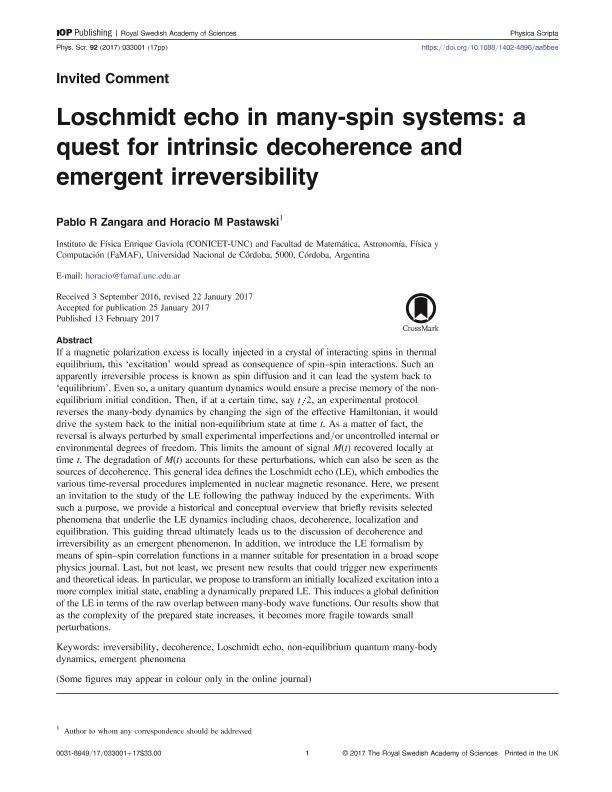Mostrar el registro sencillo del ítem
dc.contributor.author
Zangara, Pablo René

dc.contributor.author
Pastawski, Horacio Miguel

dc.date.available
2018-11-20T14:54:56Z
dc.date.issued
2017-02-13
dc.identifier.citation
Zangara, Pablo René; Pastawski, Horacio Miguel; Loschmidt echo in many-spin systems: A quest for intrinsic decoherence and emergent irreversibility; IOP Publishing; Physica Scripta; 92; 3; 13-2-2017
dc.identifier.issn
0031-8949
dc.identifier.uri
http://hdl.handle.net/11336/64725
dc.description.abstract
If a magnetic polarization excess is locally injected in a crystal of interacting spins in thermal equilibrium, this 'excitation' would spread as consequence of spin-spin interactions. Such an apparently irreversible process is known as spin diffusion and it can lead the system back to 'equilibrium'. Even so, a unitary quantum dynamics would ensure a precise memory of the non-equilibrium initial condition. Then, if at a certain time, say , an experimental protocol reverses the many-body dynamics by changing the sign of the effective Hamiltonian, it would drive the system back to the initial non-equilibrium state at time t. As a matter of fact, the reversal is always perturbed by small experimental imperfections and/or uncontrolled internal or environmental degrees of freedom. This limits the amount of signal M(t) recovered locally at time t. The degradation of M(t) accounts for these perturbations, which can also be seen as the sources of decoherence. This general idea defines the Loschmidt echo (LE), which embodies the various time-reversal procedures implemented in nuclear magnetic resonance. Here, we present an invitation to the study of the LE following the pathway induced by the experiments. With such a purpose, we provide a historical and conceptual overview that briefly revisits selected phenomena that underlie the LE dynamics including chaos, decoherence, localization and equilibration. This guiding thread ultimately leads us to the discussion of decoherence and irreversibility as an emergent phenomenon. In addition, we introduce the LE formalism by means of spin-spin correlation functions in a manner suitable for presentation in a broad scope physics journal. Last, but not least, we present new results that could trigger new experiments and theoretical ideas. In particular, we propose to transform an initially localized excitation into a more complex initial state, enabling a dynamically prepared LE. This induces a global definition of the LE in terms of the raw overlap between many-body wave functions. Our results show that as the complexity of the prepared state increases, it becomes more fragile towards small perturbations.
dc.format
application/pdf
dc.language.iso
eng
dc.publisher
IOP Publishing

dc.rights
info:eu-repo/semantics/openAccess
dc.rights.uri
https://creativecommons.org/licenses/by-nc-sa/2.5/ar/
dc.subject
Decoherence
dc.subject
Emergent Phenomena
dc.subject
Irreversibility
dc.subject
Loschmidt Echo
dc.subject
Non-Equilibrium Quantum Many-Body Dynamics
dc.subject.classification
Astronomía

dc.subject.classification
Ciencias Físicas

dc.subject.classification
CIENCIAS NATURALES Y EXACTAS

dc.title
Loschmidt echo in many-spin systems: A quest for intrinsic decoherence and emergent irreversibility
dc.type
info:eu-repo/semantics/article
dc.type
info:ar-repo/semantics/artículo
dc.type
info:eu-repo/semantics/publishedVersion
dc.date.updated
2018-10-22T18:59:44Z
dc.identifier.eissn
1402-4896
dc.journal.volume
92
dc.journal.number
3
dc.journal.pais
Reino Unido

dc.journal.ciudad
Londres
dc.description.fil
Fil: Zangara, Pablo René. Consejo Nacional de Investigaciones Científicas y Técnicas. Centro Científico Tecnológico Conicet - Córdoba. Instituto de Física Enrique Gaviola. Universidad Nacional de Córdoba. Instituto de Física Enrique Gaviola; Argentina
dc.description.fil
Fil: Pastawski, Horacio Miguel. Consejo Nacional de Investigaciones Científicas y Técnicas. Centro Científico Tecnológico Conicet - Córdoba. Instituto de Física Enrique Gaviola. Universidad Nacional de Córdoba. Instituto de Física Enrique Gaviola; Argentina
dc.journal.title
Physica Scripta

dc.relation.alternativeid
info:eu-repo/semantics/altIdentifier/doi/http://dx.doi.org/10.1088/1402-4896/aa5bee
dc.relation.alternativeid
info:eu-repo/semantics/altIdentifier/arxiv/https://arxiv.org/abs/1702.01475
dc.relation.alternativeid
info:eu-repo/semantics/altIdentifier/url/http://iopscience.iop.org/article/10.1088/1402-4896/aa5bee/meta
Archivos asociados
